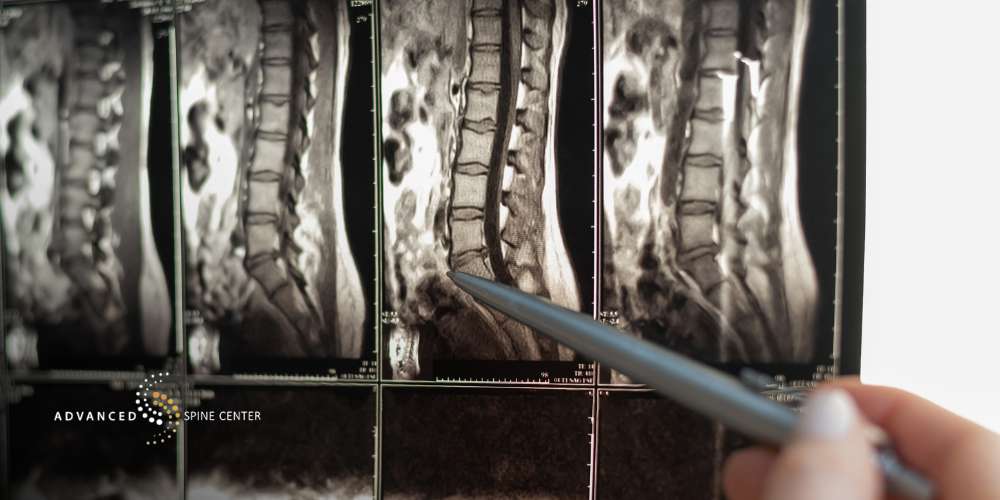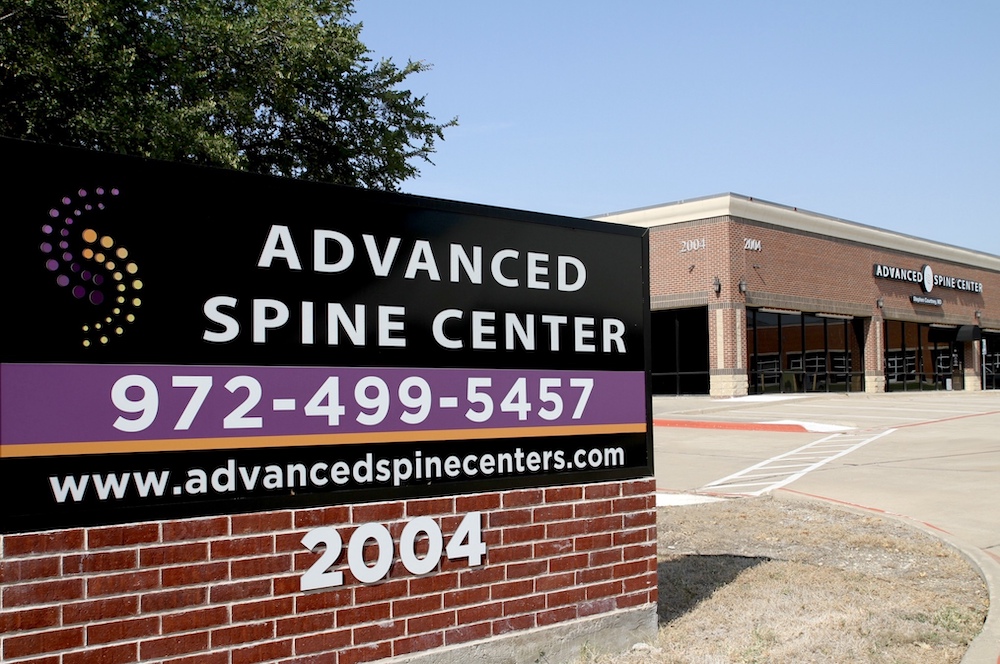Specialties

Annular Tear Treatment in Plano, TX
An annular fissure can cause intense pain and limit your ability to move freely, making everyday activities feel like a challenge. At Advanced Spine Center, our Plano orthopedic specialists are ready to provide you relief from annular tear symptoms through advanced, minimally-invasive treatments.
If you have been suffering from an annular tear and non-surgical treatments have done nothing to relieve your back pain, contact a Plano spine surgeon at Advanced Spine Center today. By using advanced surgical methods, we can repair the damaged portion of your disc with minimal disruption to surrounding tissues. This approach ensures that you can get back to your normal routine as quickly and safely as possible.
Call (972) 499-5457 to schedule an appointment with a member of our medical team and take your first step toward a pain-free future.
What Is an Annular Fissure?
An annular fissure refers to a tear or crack in the annulus fibrosus, which is the thick outer layer of an intervertebral disc in the spine. Each disc consists of a soft, gel-like center, or nucleus pulposus, surrounded by the annulus fibrosus, a fibrous ring made of concentric layers of collagen.
The annulus fibrosus acts as a protective barrier, keeping the nucleus pulposus in place and helping to absorb shock between the vertebrae. When the annulus fibrosus develops a fissure or tear, it compromises the structural integrity of the disc, potentially allowing the nucleus pulposus to shift or herniate through the tear.
Annular Tears vs Herniated Discs
While very similar to an annular fissure, a herniated disc is a slightly different spinal condition that occurs within the same structure of the spine. But what is a herniated disc, and how does it differ from an annular tear? An annular tear refers to a small crack or fissure in the outer layer of an intervertebral disc, but it does not always result in disc material leaking out.
In contrast, a herniated disc occurs when the soft, gel-like nucleus of the disc pushes through the annular tear. This can lead to spinal nerve compression, where the nerves exiting the spinal column become compressed between the herniated disc material and the bones of the spine.
While an annular tear can exist without herniation, a herniated disc typically involves both the tear and the displacement of the disc nucleus.
Is an Annular Tear Serious?
An annular tear can be serious, depending on the size and location of the tear. While some small disc tears may heal on their own over time, larger or more severe annular tears can lead to significant pain, discomfort, and mobility issues.
In some cases, these tears may allow the nucleus of the disc to leak or herniate through the outer layer of the disc, which can put pressure on surrounding nerves and cause further complications, such as sciatica or chronic pain.
Annular Tear Symptoms

The symptoms of an annular tear can vary depending on the severity of the tear and its location in the spine. Common symptoms associated with an annular tear include:
- Localized back or neck pain
- Radiating pain in the arms or legs
- Tingling or numbness
- Muscle weakness
- Difficulty with movement or bending
If you’re experiencing any of these symptoms, it’s important to seek medical attention for an accurate diagnosis and appropriate treatment plan. Annular fissures are typically diagnosed through imaging tests, such as a magnetic resonance imaging (MRI) or computed tomography (CT) scan, which provide detailed views of the spine and can reveal the presence of a torn disc.
Annular Tear Causes
Annular tears are commonly caused by the natural aging process. Over time, the discs in the spine lose hydration and flexibility, making them more susceptible to tears. These tears can also be the result of acute trauma or a traumatic injury, which can put an excessive amount of stress on the spine.
Other annular fissure causes include repetitive movements or prolonged pressure on the spine, often associated with physical labor jobs, poor posture, or excess body weight. Annular tears are also associated with spinal conditions such as degenerative disc disease, which can make spinal discs more susceptible to annular fissures, or bone spurs, which can damage the fibrous outer layer of the spine’s discs.
Types of Annular Fissures
Annular fissures can occur in different parts of the spine and in different parts of the spinal disc. Some of the different types of annular tears people can suffer from include:
- Transverse tears occur along the outermost layer of the annulus fibrosus, typically running horizontally between the layers of the disc.
- Radial tears extend from the center of the disc outward toward the edge, often leading to herniation as the inner disc material can push through the tear.
- Concentric tears form between the layers of the annulus fibrosus, running in a circular pattern parallel to the disc’s outer edge and weakening the overall structure of the disc.
Below are some of the other types of annular fissures people can suffer from.
Annular Tear of Lumbar Disc
A lumbar disc annular tear occurs in the lumbar spine, or lower back, where the spine bears a good portion of the body’s weight. This type of annular fissure is common and can lead to lower back pain, as well as radiating pain down the legs if nearby nerves are affected.
Central Annular Fissure
A central annular fissure is located in the center of the intervertebral disc, directly in front of the spinal cord. While this type of annular tear may not always cause immediate symptoms, it can lead to disc bulging or herniation over time.
Posterior Annular Fissure
A posterior annular fissure occurs at the back of the disc, closest to the spinal canal. This type of annular tear is particularly concerning as it can easily cause pressure on the spinal nerves, leading to significant pain and even neurological symptoms like tingling and numbness.
Foraminal Annular Fissure
Foraminal annular fissures are located near the intervertebral foramina, which are openings that allow spinal nerves to exit the spinal column. Annular tears in this area can cause nerve compression, leading to localized pain and possible radiating symptoms depending on which nerves are affected.
Annular Tear Surgery in Plano, TX

When conservative treatments like physical therapy, pain medication, or spinal injections fail to provide relief from the symptoms of an annular fissure, Advanced Spine Center offers surgical solutions. Our minimally invasive procedures target the damaged area of the spine, relieving pressure and reducing pain without the need for traditional open surgery.
By addressing the root cause of your discomfort, these surgical treatments help restore mobility and improve your overall quality of life. Below are some of the annular fissure surgical treatments we offer at Advanced Spine Center.
Minimally-Invasive Spine Surgery
At Advanced Spine Center in Plano, TX, we offer minimally-invasive spinal surgery options for patients suffering from annular tears. We offer foraminotomy surgery to treat annular tears by relieving pressure on the nerves in the spine. Foraminotomy involves widening the space where nerves exit the spinal column, reducing compression caused by the tear.
This procedure can help alleviate symptoms like back pain, numbness, and weakness, providing patients with significant relief and improved mobility. Our minimally-invasive approach to this procedure helps decrease the risks associated with traditional open surgery, ensuring a safer and more efficient treatment for annular tears.
Disc Bulge with Annular Tear Treatment
We are also proud to offer various surgical treatments for annular tears that lead to bulging discs. Some of these treatments include:
- Micro endoscopic discectomy
- Spinal fusion therapy, including cervical fusion and lumbar fusion
- Laminectomy
Using advanced techniques, our surgeons can remove or repair the damaged portions of the spinal disc while preserving as much healthy tissue as possible, or provide stability in the spine and prevent further complications as a result of the herniation. If you have suffered from herniated spinal discs as a result of annular fissures, contact Advanced Spine Center today and schedule an appointment.
Annular Tear Recovery Time
Recovery time from annular tear treatment can vary depending on the severity of the tear and the specific procedure performed, but most patients can expect to return to normal activities within a few weeks to a few months. To ensure a speedy recovery, it’s important to follow post-operative instructions, such as engaging in physical therapy, maintaining proper posture, and avoiding heavy lifting.
In order to maintain long-term spinal health, you should focus on strengthening your core muscles, practicing good ergonomics, and incorporating regular low-impact exercises like walking or swimming into your everyday life.
Contact the Advanced Spine Center for Neck Pain and Annular Fissure Treatment in Plano, TX

Annular fissures can be a source of significant pain, and can prevent you from doing the things you love to do. If you’re suffering from an annular tear, herniated disc, or another related spinal condition, contact the Plano orthopedic specialists at Advanced Spine Center today. We offer a range of annular fissure treatments tailored to each patient’s personal needs and goals.
With a focus on innovative, patient-centered treatment plans, we aim to offer relief that lasts. Our expertise in spinal care means that we can guide you through every step of your treatment journey, from diagnosis to recovery. We can treat a wide variety of spinal conditions and can provide a range of treatment options, so if you’re suffering from back or neck pain, don’t hesitate to call us.
Reach out to us by calling (972) 499-5457 or contacting us via our website to schedule an appointment with a member of our team.


